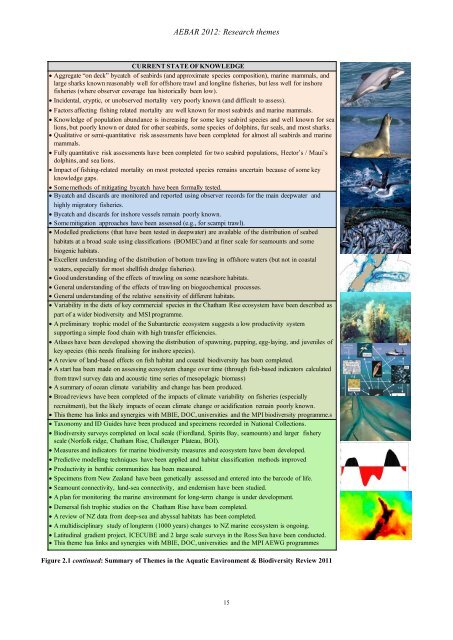Aquatic Environment and Biodiversity Annual Review 2012
Aquatic Environment and Biodiversity Annual Review 2012
Aquatic Environment and Biodiversity Annual Review 2012
You also want an ePaper? Increase the reach of your titles
YUMPU automatically turns print PDFs into web optimized ePapers that Google loves.
AEBAR <strong>2012</strong>: Research themes<br />
CURRENT STATE OF KNOWLEDGE<br />
• Aggregate “on deck” bycatch of seabirds (<strong>and</strong> approximate species composition), marine mammals, <strong>and</strong><br />
large sharks known reasonably well for offshore trawl <strong>and</strong> longline fisheries, but less well for inshore<br />
fisheries (where observer coverage has historically been low).<br />
• Incidental, cryptic, or unobserved mortality very poorly known (<strong>and</strong> difficult to assess).<br />
• Factors affecting fishing related mortality are well known for most seabirds <strong>and</strong> marine mammals.<br />
• Knowledge of population abundance is increasing for some key seabird species <strong>and</strong> well known for sea<br />
lions, but poorly known or dated for other seabirds, some species of dolphins, fur seals, <strong>and</strong> most sharks.<br />
• Qualitative or semi-quantitative risk assessments have been completed for almost all seabirds <strong>and</strong> marine<br />
mammals.<br />
• Fully quantitative risk assessments have been completed for two seabird populations, Hector’s / Maui’s<br />
dolphins, <strong>and</strong> sea lions.<br />
• Impact of fishing-related mortality on most protected species remains uncertain because of some key<br />
knowledge gaps.<br />
• Some methods of mitigating bycatch have been formally tested.<br />
• Bycatch <strong>and</strong> discards are monitored <strong>and</strong> reported using observer records for the main deepwater <strong>and</strong><br />
highly migratory fisheries.<br />
• Bycatch <strong>and</strong> discards for inshore vessels remain poorly known.<br />
• Some mitigation approaches have been assessed (e.g., for scampi trawl).<br />
• Modelled predictions (that have been tested in deepwater) are available of the distribution of seabed<br />
habitats at a broad scale using classifications (BOMEC) <strong>and</strong> at finer scale for seamounts <strong>and</strong> some<br />
biogenic habitats.<br />
• Excellent underst<strong>and</strong>ing of the distribution of bottom trawling in offshore waters (but not in coastal<br />
waters, especially for most shellfish dredge fisheries).<br />
• Good underst<strong>and</strong>ing of the effects of trawling on some nearshore habitats.<br />
• General underst<strong>and</strong>ing of the effects of trawling on biogeochemical processes.<br />
• General underst<strong>and</strong>ing of the relative sensitivity of different habitats.<br />
• Variability in the diets of key commercial species in the Chatham Rise ecosystem have been described as<br />
part of a wider biodiversity <strong>and</strong> MSI programme.<br />
• A preliminary trophic model of the Subantarctic ecosystem suggests a low productivity system<br />
supporting a simple food chain with high transfer efficiencies.<br />
• Atlases have been developed showing the distribution of spawning, pupping, egg-laying, <strong>and</strong> juveniles of<br />
key species (this needs finalising for inshore species).<br />
• A review of l<strong>and</strong>-based effects on fish habitat <strong>and</strong> coastal biodiversity has been completed.<br />
• A start has been made on assessing ecosystem change over time (through fish-based indicators calculated<br />
from trawl survey data <strong>and</strong> acoustic time series of mesopelagic biomass)<br />
• A summary of ocean climate variability <strong>and</strong> change has been produced.<br />
• Broad reviews have been completed of the impacts of climate variability on fisheries (especially<br />
recruitment), but the likely impacts of ocean climate change or acidification remain poorly known.<br />
• This theme has links <strong>and</strong> synergies with MBIE, DOC, universities <strong>and</strong> the MPI biodiversity programme.s<br />
• Taxonomy <strong>and</strong> ID Guides have been produced <strong>and</strong> specimens recorded in National Collections.<br />
• <strong>Biodiversity</strong> surveys completed on local scale (Fiordl<strong>and</strong>, Spirits Bay, seamounts) <strong>and</strong> larger fishery<br />
scale (Norfolk ridge, Chatham Rise, Challenger Plateau, BOI).<br />
• Measures <strong>and</strong> indicators for marine biodiversity measures <strong>and</strong> ecosystem have been developed.<br />
• Predictive modelling techniques have been applied <strong>and</strong> habitat classification methods improved<br />
• Productivity in benthic communities has been measured.<br />
• Specimens from New Zeal<strong>and</strong> have been genetically assessed <strong>and</strong> entered into the barcode of life.<br />
• Seamount connectivity, l<strong>and</strong>-sea connectivity, <strong>and</strong> endemism have been studied.<br />
• A plan for monitoring the marine environment for long-term change is under development.<br />
• Demersal fish trophic studies on the Chatham Rise have been completed.<br />
• A review of NZ data from deep-sea <strong>and</strong> abyssal habitats has been completed.<br />
• A multidisciplinary study of longterm (1000 years) changes to NZ marine ecosystem is ongoing.<br />
• Latitudinal gradient project, ICECUBE <strong>and</strong> 2 large scale surveys in the Ross Sea have been conducted.<br />
• This theme has links <strong>and</strong> synergies with MBIE, DOC, universities <strong>and</strong> the MPI AEWG programmes<br />
Figure 2.1 continued: Summary of Themes in the <strong>Aquatic</strong> <strong>Environment</strong> & <strong>Biodiversity</strong> <strong>Review</strong> 2011<br />
15

















